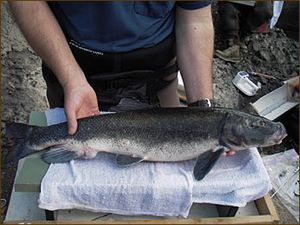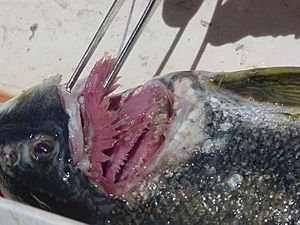Lost River sucker facts for kids
Quick facts for kids Lost River sucker |
|
|---|---|
 |
|
| Conservation status | |
| Scientific classification |
The Lost River sucker (Deltistes luxatus) is a type of ray-finned fish. It belongs to the family Catostomidae, which are often called "suckers" because of their mouth shape. This fish is the only living member of its group, Deltistes. You can only find it in parts of California and Oregon. Sadly, there are far fewer Lost River suckers now than there used to be. It is listed as an endangered species in the United States. The local Klamath Tribes Native American Nation calls this fish the C'waam.
Contents
About the Lost River Sucker
This fish is one of the biggest suckers. It can grow up to 86 centimeters (about 34 inches) long. You can spot it by its long snout, which has a small bump on top. Its back and sides are dark, while its belly is whitish or yellowish.
Lost River suckers can live for more than 40 years. However, they do not become old enough to have babies until they are between six and 14 years old. Most of them are ready to reproduce around age nine.
Where Lost River Suckers Live and How They Grow
Habitat and Food
The Lost River sucker likes deep lakes and pools. It also enjoys fast-moving water. It swims to the shoreline to find food and hide among the plants. This fish eats many different small animals. These include tiny creatures called zooplankton and other invertebrates. It also eats periphyton, which are tiny plants and algae that grow on surfaces underwater.
Reproduction and Life Cycle
Lost River suckers lay their eggs in streams. They look for areas with riffles (shallow, fast-moving water) and bottoms made of gravel and small rocks. Spawning, which is when fish lay eggs, happens in March, April, and May. A female fish can lay many eggs, sometimes up to 235,000! She will lay eggs with several males. This fish can spawn many times during its long life.
The eggs stay on the stream bottom for two or three weeks to hatch. The baby fish, called larvae, then spend 40 to 50 days growing. Young suckers find safety in plants growing near the shore.
Where They Are Found Today
This fish lives only in the Upper Klamath Basin. This area is on the border between southern Oregon and northern California. In the past, it lived in places like Upper Klamath Lake and its connecting streams. It also lived in the Lost River, Tule Lake, Lower Klamath Lake, Sheepy Lake, and Clear Lake.
Long ago, the Lost River sucker was very common in this basin. It was an important food source for the Klamath and Modoc people. Local settlers also ate it and fed it to their farm animals. There was even a factory that canned the fish for food and oil.
Today, you can find the fish in Upper Klamath Lake and its streams. They also live in Clear Lake and its streams, Tule Lake, and parts of the Lost River and Klamath River. Their living area has shrunk a lot. This happened because dams were built and water was moved away. Also, marshes were dug up and drained. New types of fish were brought into the area, which also caused problems.
The land changed a lot for farming and raising animals. Trees were cut down for timber, and plants along the rivers were removed. The water in Upper Klamath Lake also became polluted, a process called Eutrophication. This is a big reason why this fish and others in the area are struggling to survive.
Protecting the Lost River Sucker
Many things have harmed the Lost River sucker. People are now working to protect them.
Impact of Dams and Water Use
When the first dams were built, much of the fish's spawning habitat was destroyed. Dams also split up the fish's living areas. This made it hard for different groups of fish to move around and find each other. Many water projects moved river flows away. This made streams shallower and caused water to become still in some places. These changes were bad for the fish.
Irrigation canals, which carry water to farms, have trapped suckers. The pumps used in these canals can also kill the fish. Even tiny fish larvae can get trapped.
Wetland Loss and Water Quality
About 70% of the wetlands around Upper Klamath Lake have been blocked off and drained. These wetlands were important places for young suckers to grow. Healthy wetlands also help clean the water by soaking up things like phosphorus. Too much phosphorus causes huge growths of tiny organisms, especially a type of bacteria called Aphanizomenon flos-aquae.
These growths, called blooms, have caused many suckers to die. This happens because the blooms use up all the oxygen in the water. The water quality in Upper Klamath Lake is poor, especially in the summer. Even though suckers can handle bad water better than some other fish, many have died because of it.
Threats from Other Species and Diseases
New fish species have been brought into the area. These include brown bullhead, fathead minnow, yellow perch, and largemouth bass. Some of these fish, especially the fathead minnow and yellow perch, eat young suckers. These new species may also compete with the suckers for food and space.
Diseases can also make the fish sick or kill them. Many suckers have been seen with "gill rot," a disease that causes sores on their gills. This disease is caused by a bacterium called Flavobacterium columnare. Scientists think this happens when the fish are weaker because of polluted water. A tiny creature called a copepod (from the genus Lernea) is also becoming more common. This copepod attaches to the fish and feeds on them, causing wounds.
Conservation Efforts
Many projects are working to restore the habitat of the Lost River sucker. Hundreds of these projects have started in the Upper Klamath Basin. It is still too early to know if these efforts will help the number of suckers grow.
- Gimenez Dixon, M. 1996. Deltistes luxatus. 2011 IUCN Red List of Threatened Species. Downloaded on 4 October 2011.
See also
 In Spanish: Deltistes luxatus para niños
In Spanish: Deltistes luxatus para niños



